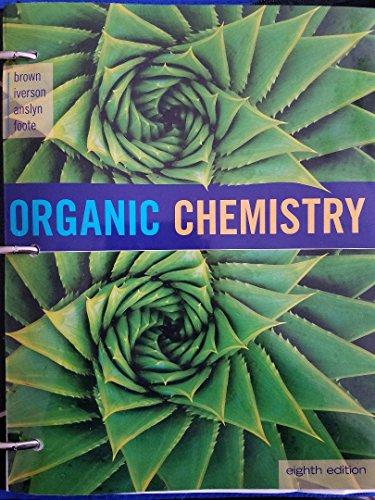
(a)
Interpretation:
The mechanism(s) that matches with given statement has to be given.
(b)
Interpretation:
The mechanism(s) that matches with given statement has to be given.
(c)
Interpretation:
The mechanism(s) that matches with given statement has to be given.
(d)
Interpretation:
The mechanism(s) that matches with given statement has to be given.
(e)
Interpretation:
The mechanism(s) that matches with given statement has to be given.
(f)
Interpretation:
The mechanism(s) that matches with given statement has to be given.
(g)
Interpretation:
The mechanism(s) that matches with given statement has to be given.
(h)
Interpretation:
The mechanism(s) that matches with given statement has to be given.
(i)
Interpretation:
The mechanism(s) that matches with given statement has to be given.
(j)
Interpretation:
The mechanism(s) that matches with given statement has to be given.
(k)
Interpretation:
The mechanism(s) that matches with given statement has to be given.
Trending nowThis is a popular solution!

Chapter 9 Solutions
Organic Chemistry, Loose-leaf Version
- Consider the following statement in reference to SN1, SN2, E1, and E2 reactions of haloalkanes. To which mechanism(s), if any, does the statement apply? Involves a carbocation intermediatearrow_forwardConsider the following statement in reference to SN1, SN2, E1, and E2 reactions of haloalkanes. To which mechanism(s), if any, does the statement apply? Is first order in haloalkane and zero order in basearrow_forwardConsider the following statement in reference to SN1, SN2, E1, and E2 reactions of haloalkanes. To which mechanism(s), if any, does the statement apply? Is first order in haloalkane and first order in base.arrow_forward
- Compound D, shown below, reacts with hydrogen bromide by electrophilic addition. A mixtur organic compounds, E and F, is formed. CH₂CH3 CH3 CH₂ HBr Time left 0:45:55 Mixture of organic compounds E and F H compound D (i) Name the the two organic compounds E and F and show their condensed formula. (ii) Briefly explain the mechanism of the reaction between compound and hydrogen bromide to form either compound E or compound F. You can listature the main dept) (ii) Which comprand. E or F is the major productarrow_forwardFor the following sets of substitution reactions that occur via an SN2 mechanism, draw the main organic substitution product (i.e., not the leaving group, for each reaction draw the product, though the products may be equivalent) and indicate which reaction occurs at the faster rate. (a) H3C CH₂O H3C E H3C Br (b) Br CH3O H3C + H3C-Br CH3O- H3C-Brarrow_forwardGive answers in detail with exarrow_forward
- Please give the main substitution product for each of the following reactions, and indicate the dominant mechanism: (a) 1-bromopropane + NaOCH3 → (b) 3-bromo-3-methylpentane + NaOC2H5 →arrow_forwardLabel the following as: SN1, SN2, E1, E2 reactions. Create examples with drawn mechanisms.arrow_forwardYou have learned how secondary alkyl halides are usually good substrates for SN1 and SN2 reactions. Chlorocyclopropane, however, will not react under either of the following conditions: (a) sodium methoxide in methanol or (b) methanol. Explain non-verbally why the two conversions fail.arrow_forward
- A problem often encountered in the oxidation of primary alcohols to acids is that esters are sometimes produced as by-products. For example, oxidation of ethanol yields acetic acid and ethyl acetate: Propose a mechanism to account for the formation of ethyl acetate. Take into account the reversible reaction between aldehydes and alcohols:arrow_forward(a) In an acid-catalyzed hydration, one of the following 10 carbon alkynes is expected to produce a single hydration product? Select the correct alkyne and draw the structure of the hydration product that is formed from this alkyne. (I) 2-decyne; (II) 3-decyne; (III) 4-decyne; (IV) 5-decyne; (V) none of these will give a single hydration product. (b) The reaction shown below gives Compound X as the major product. The mass spectrum of X is shown. Br2, H20 Compound X 100 - MS-IW-5644 80 60 40 - 20 - 20 40 60 80 100 120 140 160 180 200 220 m/z Considering the reactions of alkynes and the MS data, de duce which of following structures corresponds to X: Br Br HO, IV V I II II Support your answer with a reaction mechanism for fomation of X and identification of relevant peaks in the mass spectrum. 12 Relative Intensityarrow_forwardWhen the alkyl bromides (listed here) were subjected to hydrolysis in a mixture of ethanol and water (80% EtOH/20% H2O) at 55 °C, the rates of the reaction showed the following order: (CH3)3CBR > CH3Br > CH3CH2Br > (CH3)2CHBR Provide an explanation for this order of reactivity.arrow_forward
 Organic ChemistryChemistryISBN:9781305580350Author:William H. Brown, Brent L. Iverson, Eric Anslyn, Christopher S. FootePublisher:Cengage Learning
Organic ChemistryChemistryISBN:9781305580350Author:William H. Brown, Brent L. Iverson, Eric Anslyn, Christopher S. FootePublisher:Cengage Learning Organic Chemistry: A Guided InquiryChemistryISBN:9780618974122Author:Andrei StraumanisPublisher:Cengage Learning
Organic Chemistry: A Guided InquiryChemistryISBN:9780618974122Author:Andrei StraumanisPublisher:Cengage Learning


